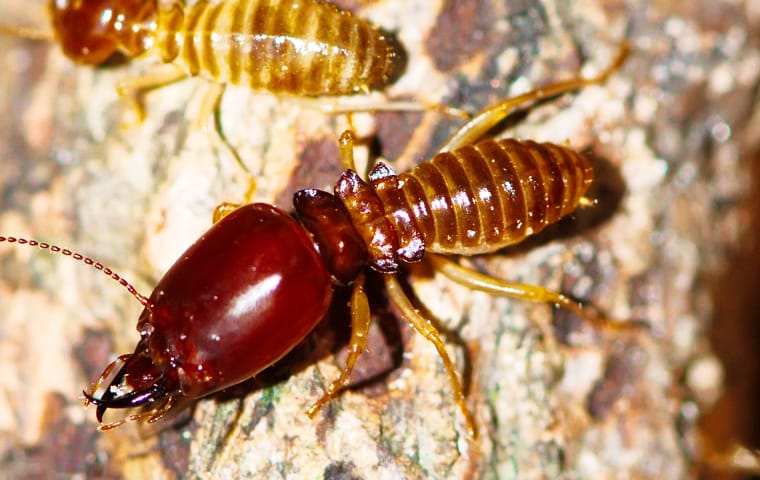
Termite Identification & Prevention
What Are Termites?

Termites are social insects that live together in large colonies. Subterranean termites nest in the ground and feed on materials made of cellulose. In nature, they are beneficial and help to break down decaying wood and other organic materials. In contrast, when inside of homes, termites are highly destructive and cause over five-billion dollars in damage in the U.S. each year.
They divide themselves into three different groups, or castes: workers, soldiers, and reproductives; a termite's appearance is dependent on its specific caste. Workers, which make up the majority of the colony, are blind and have soft, cream colored bodies. Soldiers have elongated, yellowish-colored heads and large jaws that they use to defend the colony. Reproductive members (kings and queens) have dark-colored bodies and are the only members of the colony that have wings.
Are termites dangerous?
Subterranean termites don’t pose a direct threat to people; in fact, we rarely come into contact with these ground-nesting species of insects. However, they are extremely dangerous to properties. Their feeding habits cause extensive and expensive damage inside of a structure. Additionally, termite damage is not covered by most homeowners insurance, meaning that repair costs tend to come out of pocket. Workers enter homes from the ground unseen and work silently for months or even years. They are generally only discovered after doing serious damage to major structures. The only other time you may realize termites are near your property is after witnessing a termite swarm. These swarms occur when large numbers of winged reproductive members emerge from a mature colony to mate and create another colony, usually during the day.
Why do I have a termite problem?

Dynasty Pest Control's Blog
-
Comparing DIY Vs Professional Mosquito ControlRead More
-
 Dealing With Squirrels In Dallas: Wildlife Control StrategiesRead More
Dealing With Squirrels In Dallas: Wildlife Control StrategiesRead More -
 A Guide To Preventive Spider Pest Control Measures In MidlothianRead More
A Guide To Preventive Spider Pest Control Measures In MidlothianRead More -
 Answering Dallas' Most Frequently Asked Cockroach QuestionsRead More
Answering Dallas' Most Frequently Asked Cockroach QuestionsRead More -
 How To Repair And Avoid Termite Damage In DallasRead More
How To Repair And Avoid Termite Damage In DallasRead More -
 What Is The Best Way To Keep Bed Bugs Out Of My Dallas Home?Read More
What Is The Best Way To Keep Bed Bugs Out Of My Dallas Home?Read More -
 The Best Way To Keep The Raccoons In Dallas Out Of Your YardRead More
The Best Way To Keep The Raccoons In Dallas Out Of Your YardRead More -
 A Guide To Dealing With Termite Damage In DallasRead More
A Guide To Dealing With Termite Damage In DallasRead More -
 Are You Struggling With Bed Bugs In Your Dallas Business?Read More
Are You Struggling With Bed Bugs In Your Dallas Business?Read More -
 The Trick To Effective Roach Control In DallasRead More
The Trick To Effective Roach Control In DallasRead More -
 How To Get Rid Of A Dangerous Cockroach Infestation In DallasRead More
How To Get Rid Of A Dangerous Cockroach Infestation In DallasRead More -
 Fleas 101: What Midlothian Residents Need To KnowRead More
Fleas 101: What Midlothian Residents Need To KnowRead More -
 Why Do I Have Bed Bugs In My Dallas Home?Read More
Why Do I Have Bed Bugs In My Dallas Home?Read More -
 Threats Rodents Pose in Dallas, TXRead More
Threats Rodents Pose in Dallas, TXRead More -
 How To Get Rid Of Cockroaches: A Step-By-Step Guide For Dallas HomeownersRead More
How To Get Rid Of Cockroaches: A Step-By-Step Guide For Dallas HomeownersRead More -
 How Much Do You Really Know About Dangerous Cockroaches In Dallas?Read More
How Much Do You Really Know About Dangerous Cockroaches In Dallas?Read More -
 A Helpful Guide To Rat Control For Dallas Property OwnersRead More
A Helpful Guide To Rat Control For Dallas Property OwnersRead More -
 Dallas Property Owners' Ultimate Termite-Protection GuideRead More
Dallas Property Owners' Ultimate Termite-Protection GuideRead More -
 Are You Struggling With Mosquito Control In Dallas?Read More
Are You Struggling With Mosquito Control In Dallas?Read More -
 The Best Way To Prepare For Peak Mosquito Season In DallasRead More
The Best Way To Prepare For Peak Mosquito Season In DallasRead More -
 Don't Let The Bed Bugs Bite: The Effective Control Solution For Your Dallas HomeRead More
Don't Let The Bed Bugs Bite: The Effective Control Solution For Your Dallas HomeRead More -
 A Quick Guide To Bed Bugs In DallasRead More
A Quick Guide To Bed Bugs In DallasRead More -
 What You Should Know About Treating Your Dallas Home For TermitesRead More
What You Should Know About Treating Your Dallas Home For TermitesRead More -
 Why Every Home In Dallas Should Be Protected From PestsRead More
Why Every Home In Dallas Should Be Protected From PestsRead More -
 The Secret To Getting Cockroaches Out Of Your Dallas HomeRead More
The Secret To Getting Cockroaches Out Of Your Dallas HomeRead More -
 Dallas Homeowner's Cockroach-Prevention GuideRead More
Dallas Homeowner's Cockroach-Prevention GuideRead More -
 The Hardest Pest To Detect In McKinney May Be The Most DamagingRead More
The Hardest Pest To Detect In McKinney May Be The Most DamagingRead More -
 Why Carpenter Ants Invade Dallas HomesRead More
Why Carpenter Ants Invade Dallas HomesRead More -
 How To Prep Your Dallas Home For Termite SeasonRead More
How To Prep Your Dallas Home For Termite SeasonRead More -
 How Dangerous Is It To Have Bed Bugs In My Dallas Home?Read More
How Dangerous Is It To Have Bed Bugs In My Dallas Home?Read More -
 Rodent Control 101: Essential Tips For Keeping Your Midlothian Home SafeRead More
Rodent Control 101: Essential Tips For Keeping Your Midlothian Home SafeRead More -
 What Should I Know About Acrobat Ants In Dallas?Read More
What Should I Know About Acrobat Ants In Dallas?Read More -
 The Ultimate Guide To Mosquito Control: Tips And Tricks For Your Dallas PropertyRead More
The Ultimate Guide To Mosquito Control: Tips And Tricks For Your Dallas PropertyRead More -
 How Do I Keep Spiders Out Of My Dallas Home?Read More
How Do I Keep Spiders Out Of My Dallas Home?Read More -
 What is the Best Way To Keep Norway Rats Out of My Dallas, TX HomeRead More
What is the Best Way To Keep Norway Rats Out of My Dallas, TX HomeRead More -
 3 Things McKinney Residents Can Do to Avoid RodentsRead More
3 Things McKinney Residents Can Do to Avoid RodentsRead More -
 Dallas Property Owner's Complete Guide To Effective Mosquito ControlRead More
Dallas Property Owner's Complete Guide To Effective Mosquito ControlRead More -
 Rodent Rundown: Keeping These Dangerous Pests Away From Your Dallas PropertyRead More
Rodent Rundown: Keeping These Dangerous Pests Away From Your Dallas PropertyRead More -
 Dealing With Nuisance Wildlife: Effective Strategies For Control And Prevention In DallasRead More
Dealing With Nuisance Wildlife: Effective Strategies For Control And Prevention In DallasRead More -
 The Most Effective Way To Deal With Bed Bugs In Your Dallas HomeRead More
The Most Effective Way To Deal With Bed Bugs In Your Dallas HomeRead More -
 Why Are There So Many Spiders Living In My Dallas Home?Read More
Why Are There So Many Spiders Living In My Dallas Home?Read More -
 Tips And Tricks To Help With Spider Prevention In DallasRead More
Tips And Tricks To Help With Spider Prevention In DallasRead More -
 Homeowners Guide To A Pest-Free Holiday SeasonRead More
Homeowners Guide To A Pest-Free Holiday SeasonRead More -
 Here's A Quick Way To Tell If You Have A Carpenter Ant Problem In Your Dallas HomeRead More
Here's A Quick Way To Tell If You Have A Carpenter Ant Problem In Your Dallas HomeRead More -
 Sealing Off Rodent Entry Points Around Your Dallas ResidenceRead More
Sealing Off Rodent Entry Points Around Your Dallas ResidenceRead More -
 What Every Dallas Property Owner Ought To Know About Brown Recluse SpidersRead More
What Every Dallas Property Owner Ought To Know About Brown Recluse SpidersRead More -
 What Every Dallas Homeowner Should Know About Subterranean TermitesRead More
What Every Dallas Homeowner Should Know About Subterranean TermitesRead More -
 How You Can Prepare Your Dallas Home For Termite SeasonRead More
How You Can Prepare Your Dallas Home For Termite SeasonRead More -
 Are The Spiders I Find In My Dallas, TX Home Dangerous?Read More
Are The Spiders I Find In My Dallas, TX Home Dangerous?Read More -
 Dallas Resident's Complete Guide To Flea ControlRead More
Dallas Resident's Complete Guide To Flea ControlRead More -
 American Cockroaches In Dallas: Should You Be Concerned?Read More
American Cockroaches In Dallas: Should You Be Concerned?Read More -
 Are The Spiders In Dallas And Surrounding Areas Hard To Get Rid Of?Read More
Are The Spiders In Dallas And Surrounding Areas Hard To Get Rid Of?Read More -
 What Everyone In Dallas Ought To Know About Termite SwarmersRead More
What Everyone In Dallas Ought To Know About Termite SwarmersRead More -
 Mosquitoes Still Active In Dallas: What Homeowners Need To KnowRead More
Mosquitoes Still Active In Dallas: What Homeowners Need To KnowRead More -
 Why Professional Rodent Control Is A Must-Have In MidlothianRead More
Why Professional Rodent Control Is A Must-Have In MidlothianRead More -
 Why You Should Call The Professionals About Rodents In Your Dallas HomeRead More
Why You Should Call The Professionals About Rodents In Your Dallas HomeRead More -
 Dallas Resident's Comprehensive Guide To Brown Recluse SpidersRead More
Dallas Resident's Comprehensive Guide To Brown Recluse SpidersRead More -
 When Is Termite Season In Dallas?Read More
When Is Termite Season In Dallas?Read More -
 What You Should Know About Wolf Spiders In DallasRead More
What You Should Know About Wolf Spiders In DallasRead More

How can I prevent termites in the future?
In addition to investing in professional termite control, you can help keep destructive termites out of your home or business with the help of the following prevention tips:
- Prevent wooden structures from becoming water damaged by properly treating the wood.
- Remove fallen trees, tree limbs, leaf piles, and similar debris from your property.
- Leave an 18-20 inch barrier between the foundation and any mulch or soil.
- Fix leaky pipes or fixtures in or around your home or business.
- Seal up entry points in the foundation of your property.
- Limit wood to soil contact on your property and around your property.
- Reduce humidity levels in your home or business by using dehumidifiers.
- Remove structural wood from your property that has been damaged by water.
- Store all firewood up off of the ground and away from the exterior of your property.
- Place weather-stripping around windows and doors and maintain gutters to stop water from seeping into your home.
-
“Mario has been servicing our home since we moved and he’s the best. We have not had any issues in our home and we thank Mario and Dynasty for that!”- Kaitlyn P.
-
“I'm highly impressed with his passion and knowledge and look forward to working with him, and Dynasty Pest Control in the future!”- Heather V.
-
“Jessie was our technician this time and I couldn’t be happier with his service. He inspected my kitchen sink area which is my problem area. He clearly explained why I was having this problem, how he would treat it today and what to expect!”- Bethany H.
-
“We’ve used their quarterly services for three years now and also the mosquito control add-on. The company is top-notch from scheduling our appointments to the service technicians like Jessie and Garrison!”- Crystal C.
-
“Zach is extremely knowledgeable, professional, and thorough. He is very efficient and provides excellent service.”- Steve U.
.2402270801550.jpg)
.2402270819550.jpg)
.2402270822550.jpg)





















































